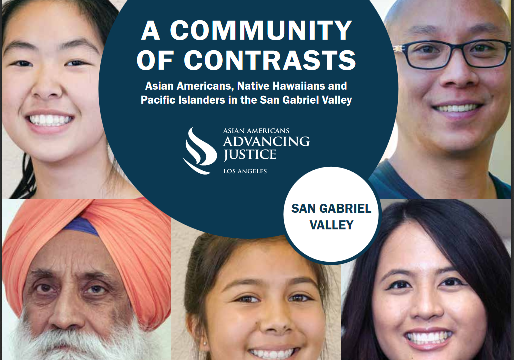By Angel Trazo
AsAmNews Intern
A new report published by Asian Americans Advancing Justice – Los Angeles (AAAJ-LA) provides insight on the often overlooked diversity and differential needs of the Asian American & Native Hawaiian Pacific Islander communities of San Gabriel Valley.
The San Gabriel Valley (SGV) is home to nearly 525,000 Asian Americans and 7,000 Native Hawaiians and Pacific Islanders (NHPI), a population greater than that in 42 states and in the cities of Los Angeles, San Francisco, and Chicago.
The dominant ethnicity by far is Chinese, followed by Filipinos, Vietnamese, and Koreans, according to the new report Community of Contrasts: Asian Americans, Native Hawaiians and Pacific Islanders in the San Gabriel Valley. San Gabriel Valley’s AA&NHPI population continues to increase its ethnic diversity, with South Asians and Figans and Tongans among the fastest-growing Asian American and NHPI groups, respectively.
LATEST STORIES
Data is disaggregated by ethnic group, much like the recent AA&NHPI Orange County Report.
“Why do we disaggregate data?” Stewart Kwoh, President and Executive Director of Advancing Justice-LA, asked during the San Gabriel Demographic Report Launch Event on Wednesday.
“You’ll see in this report that there’s some groups that die of cancer at high rates. And there’s some groups that die of heart disease at high rates. Why would you want to treat the group that has high cancer rates for people who have high heart disease?” Kwoh explained. “You have to disaggregate the data so you can treat people in the right ways.”
Our latest #communityofcontrasts report on the #SGV is hot off the presses. Check it out: https://t.co/fd99H4h7fg pic.twitter.com/bFuwde4MhX
— Advancing Justice-LA (@AAAJ_LA) February 21, 2018
The report is divided into topics relevant to the AA&NHPI community: economic contributions, civic engagement, immigration, language, education, income, employment, housing, health, and environmental justice. The last section provides policy recommendations on each topic.
Together, these findings use disaggregated data to combat the Model minority myth that has been propagated for several decades and reinforced by aggregated reports claiming that Asian Americans are well-educated and financially successful.
For example, in direct contrast to the Model minority narrative, the report shows that approximately 66,700 Asian Americans and 1,000 NHPI in the San Gabriel Valley live in poverty.
In addition, Chinese American adults aged 25 and older are less likely than Whites to hold high school or college degrees. Among Asian American groups, Vietnamese Americans are least likely to hold a college degree.
The report also illustrates the impact immigration has had on the San Gabriel Valley.
Two-thirds of Asian Americans and one-forth of NHPI living in the San Gabriel Valley are immigrants.
In addition, approximately 58,000 undocumented Asian Americans live in the San Gabriel Valley, an estimate gauged from the nation’s geographic distribution of undocumented immigrants from Asia.
One main takeaway from the report was a call for greater coalition building between the AA&NHPI and Latino communities around immigrant rights issues. The needs of Asian and Latino communities have become more pressing, as these groups now comprise 74% of the San Gabriel Valley population.
Building solidarity between Asians and Latinos is not only relevant for immigration rights, but also for furthering the fight for affordable housing.
Annie Fox, a panelist at the SGV Report launch, has spent the last two years working with LA Voice and the Latino community toward achieving affordable housing. She expressed, “The truth is, if I ask most Latinos what the cause of housing un-affordability is, they would say, it’s Asian American families investing in housing.”
Despite this comment’s allusion to the Model minority myth, unaffordable housing is a serious issue for Asian Americans in the San Gabriel Valley.
Data shows that roughly 69,000 Asian Americans are housing-cost burdened, meaning they spend 30% or more of their household income on housing costs.
“For me, the thing that is most concerning in the SGV is the belief (in the ‘Model minority’), particularly from conservative groups, and that it can wedge the beautiful diversity of communities in this valley against each other,” Fox expressed. “Our ability to come together as various communities and resist the narratives of fearing each other is to vital the future of this community, as well as our unwillingness to blame any one community for what we’re all struggling in together.”
Some other findings of the report include:
- The Asian American population continues to grow at a rate significantly faster than any other ethnic group.
- Almost half of Asian Americans are limited English proficient (LEP).
- Language barriers are a major obstacle preventing the AA&NPI community from accessing critical services, namely health care.
- Cancer is the leading cause of death for Asian Americans in the SGV.
- Over 25% of the San Gabriel Valley suffers from serious air pollution.
AsAmNews has Asian America in its heart. We’re an all-volunteer effort of dedicated staff and interns. Check out our Facebook page and our Twitter feed, Please consider interning, joining our staff or submitting a story for consideration.








